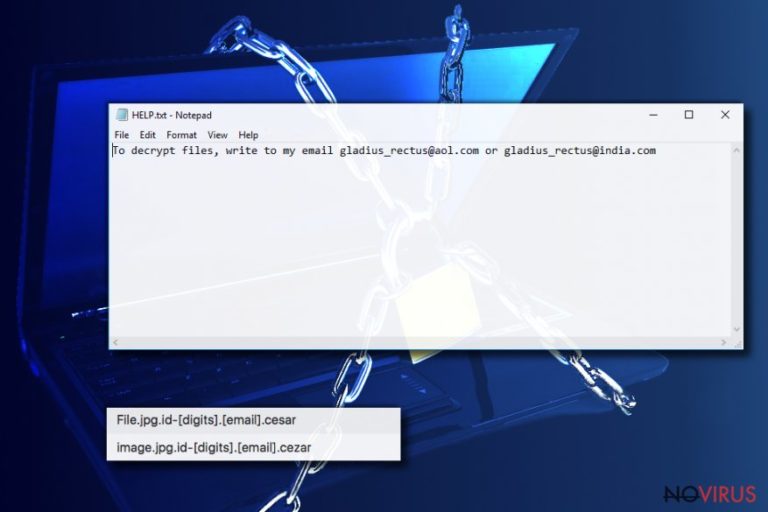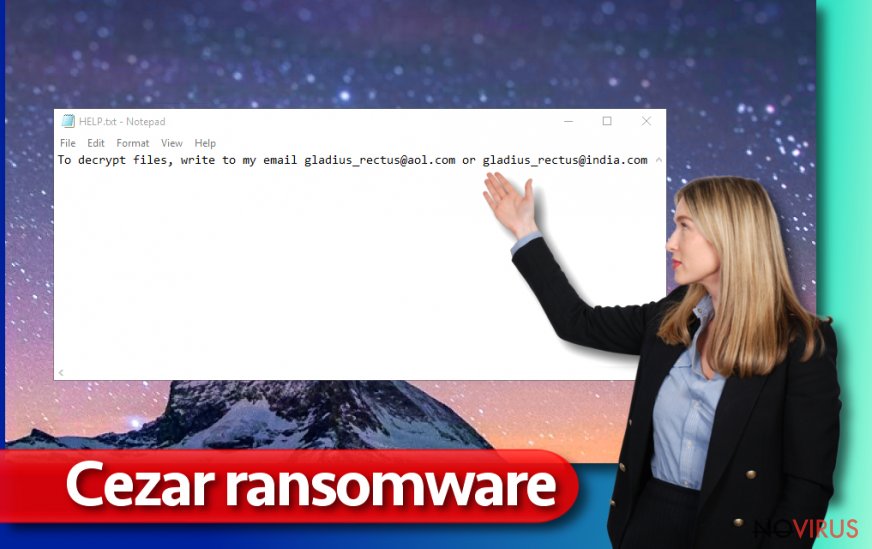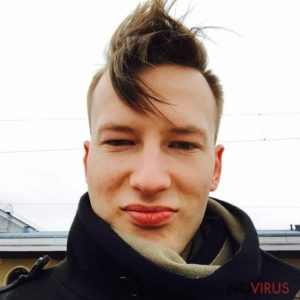Uninstall Cezar virus (Virus Removal Instructions) - Aug 2017 updated
Cezar virus Removal Guide
Description of Cezar ransomware
Developers of Dharma virus present new crypto-malware – Cezar ransomware

Cezar ransomware is a new version of a Dharma virus that usually enters the system via malicious spam email and encrypts files using the sophisticated cipher. During data encryption, it locks files with .cezar or .cesar file extension and delivers a short ransom note in HELP.txt file.
The updated version of Dharma barely differs from the original malware. It seems that the only significant change is a new file extension to targeted files. Cezar virus aims at PDF files. MS Office documents, virtual drives, various types of pictures, audios or videos. Security experts suspected that ransomware uses AES encryption to corrupt the files. Besides, it appends a long and informational extension:
- .id-.[JasonStewem@aolonline.top].cesar,
- .id-.[btc2017@india.com].cezar.
The ransom note is short. Hacker just asks to send him (or her) an email to gladius_rectus@aol.com and learn about data recovery possibility. There’s no doubt that victims are asked to pay the ransom. However, it's not sure how much. Though, this method is not reliable and might end up with an even bigger loss.
Unfortunately, Cezar removal won’t help to get back access to your files as well. The virus might delete Shadow Volume Copies, so using third-party decryption tools might not give the best results. However, some of the Dharma decryption keys might were leaked and some versions of malware are decryptable. Thus, this decryption software might updated soon. Just be patient!
Getting rid of the virus quickly is important because crypto-malware makes numerous changes to the Windows OS. It might alter Windows Registry entries, block computer’s security, delete or modify other system processes. Thus, using a computer infected with Cezar malware is not safe.
The only safe way to remove Cezar without causing any problems to the system is employing security software. We recommend for this task FortectIntego. The instructions how to disable the virus and run anti-malware is given at the end of the article.

The analysis of ransomware distribution methods
Cezar ransomware might be spread using various strategies and methods, such as:
- malicious spam email attachments,
- bogus security software downloaders,
- fake updates,
- spam websites,
- game cracks,
- key generators.
As you can see, there are numerous ways how ransomware can enter the system. However, malicious spam emails remain the main distribution method. Social engineering helps to trick users into opening obfuscated Word documents and looking for important content.
Researchers report that this version of Dharma spreads via Macro-enabled Word documents. Thus, in order to launch the attack, users have to click “Enable Content” button. However, you should never open any files sent from unknown senders.
Wipe out Cezar ransomware virus from the computer safely and quickly
Cezar removal is performed with professional antivirus or anti-malware. However, malware might block access to the security software or prevent from installing it. For this reason, the first elimination step requires disabling the virus (the instructions below).
When the virus is paralyzed, you have to install security program, for instance, FortectIntego, Malwarebytes or SpyHunter 5Combo Cleaner. Then update it and run a full system scan to remove Cezar virus entirely. Keep in mind that malware elimination will not restore your files. For that, you can try alternative recovery methods. ransomware
Getting rid of Cezar virus. Follow these steps
In-depth guide for the Cezar elimination
Follow these steps to disable the virus and remove it:
Important! →
The elimination guide can appear too difficult if you are not tech-savvy. It requires some knowledge of computer processes since it includes system changes that need to be performed correctly. You need to take steps carefully and follow the guide avoiding any issues created due to improper setting changes. Automatic methods might suit you better if you find the guide too difficult.
Step 1. Launch Safe Mode with Networking
Safe Mode environment offers better results of manual virus removal
Windows 7 / Vista / XP
- Go to Start.
- Choose Shutdown, then Restart, and OK.
- When your computer boots, start pressing the F8 button (if that does not work, try F2, F12, Del, etc. – it all depends on your motherboard model) a few times until you see the Advanced Boot Options window.
- Select Safe Mode with Networking from the list.

Windows 10 / Windows 8
- Right-click the Start button and choose Settings.

- Scroll down to find Update & Security.

- On the left, pick Recovery.
- Scroll to find Advanced Startup section.
- Click Restart now.

- Choose Troubleshoot.

- Go to Advanced options.

- Select Startup Settings.

- Press Restart.

- Choose 5) Enable Safe Mode with Networking.
Step 2. End questionable processes
You can rely on Windows Task Manager that finds all the random processes in the background. When the intruder is triggering any processes, you can shut them down:
- Press Ctrl + Shift + Esc keys to open Windows Task Manager.
- Click on More details.

- Scroll down to Background processes.
- Look for anything suspicious.
- Right-click and select Open file location.

- Go back to the Process tab, right-click and pick End Task.
- Delete the contents of the malicious folder.
Step 3. Check the program in Startup
- Press Ctrl + Shift + Esc on your keyboard again.
- Go to the Startup tab.
- Right-click on the suspicious app and pick Disable.

Step 4. Find and eliminate virus files
Data related to the infection can be hidden in various places. Follow the steps and you can find them:
- Type in Disk Cleanup in Windows search and press Enter.

- Select the drive (C: is your main drive by default and is likely to be the one that has malicious files in) you want to clean.
- Scroll through the Files to delete and select the following:
Temporary Internet Files
Downloads
Recycle Bin
Temporary files - Pick Clean up system files.

- You can also look for other malicious files hidden in the following folders (type these entries in Windows Search and press Enter):
%AppData%
%LocalAppData%
%ProgramData%
%WinDir%
After you are finished, reboot the PC in normal mode.
Eliminate Cezar using System Restore
-
Step 1: Restart your computer in Safe Mode with Command Prompt
Windows 7 / Vista / XP- Go to Start → Shutdown → Restart → OK.
- As soon as your computer starts, start pressing F8 key repeatedly before the Windows logo shows up.
-
Choose Command Prompt from the list

Windows 10 / Windows 8- Click on the Power button at the Windows login screen, and then press and hold Shift key on your keyboard. Then click Restart.
- Then select Troubleshoot → Advanced options → Startup Settings and click Restart.
-
Once your computer starts, select Enable Safe Mode with Command Prompt from the list of options in Startup Settings.

-
Step 2: Perform a system restore to recover files and settings
-
When the Command Prompt window appears, type in cd restore and press Enter.

-
Then type rstrui.exe and hit Enter..

-
In a new window that shows up, click the Next button and choose a restore point that was created before the infiltration of Cezar and then click on the Next button again.


-
To start system restore, click Yes.

-
When the Command Prompt window appears, type in cd restore and press Enter.
Bonus: Restore your files
Using the tutorial provided above you should be able to eliminate Cezar from the infected device. novirus.uk team has also prepared an in-depth data recovery guide which you will also find above.Currently, only backups can let you to bring back all your files. If you do not have them, please try alternative methods and wait for the release of the official decryptor.
There are a couple of methods you can apply to recover data encrypted by Cezar:
Data Recovery Pro is helpful after ransomware attack
This tool helps to restore corrupted files. Thus, it might help after ransomware attack too.
- Download Data Recovery Pro;
- Install Data Recovery on your computer following the steps indicated in the software’s Setup;
- Run the program to scan your device for the data encrypted by Cezar ransomware;
- Recover the data.
Chances to use ShadowExplorer
If Cezar ransomware virus failed to delete Volume Shadow Copies, this tool might help you to restore them. Follow these steps:
- Download Shadow Explorer (http://shadowexplorer.com/);
- Install Shadow Explorer on your computer following the instructions in the software’s Setup Wizard;
- Run the program. Navigate to the menu on the top-left corner and select a disk containing your encrypted files. Look through the available folders;
- When you find the folder you want to recover, right-click it and select “Export”. Also, choose where the recovered data will be stored.
Cezar Decryptor is not available yet.
It is strongly recommended to take precautions and secure your computer from malware attacks. To protect your PC from Cezar and other dangerous viruses, you should install and keep a powerful malware removal tool, for instance, FortectIntego, SpyHunter 5Combo Cleaner or Malwarebytes.
How to prevent from getting ransomware
Prevent the government from spying on you
As there is a growing debate in government about collecting users' data and spying on citizens, you should take a closer look at this issue and find out what shady ways of gathering information can be used to collect information about you. You need to browse anonymously if you want to avoid any government-initiated spying and tracking of information.
You can enjoy secure internet browsing and minimize the risk of intrusion into your system if you use Private Internet Access VPN program. This VPN application creates a virtual private network and provides access to the required data without any content restrictions.
Control government and other third party access to your data and ensure safe web browsing. Even if you do not engage in illegal activities and trust your ISP, we recommend being careful about your security. You should take extra precautions and start using a VPN program.
Recover files damaged by a dangerous malware attack
Despite the fact that there are various circumstances that can cause data to be lost on a system, including accidental deletion, the most common reason people lose photos, documents, videos, and other important data is the infection of malware.
Some malicious programs can delete files and prevent the software from running smoothly. However, there is a greater threat from the dangerous viruses that can encrypt documents, system files, and images. Ransomware-type viruses focus on encrypting data and restricting users’ access to files, so you can permanently lose personal data when you download such a virus to your computer.
The ability to unlock encrypted files is very limited, but some programs have a data recovery feature. In some cases, the Data Recovery Pro program can help recover at least some of the data that has been locked by a virus or other cyber infection.







